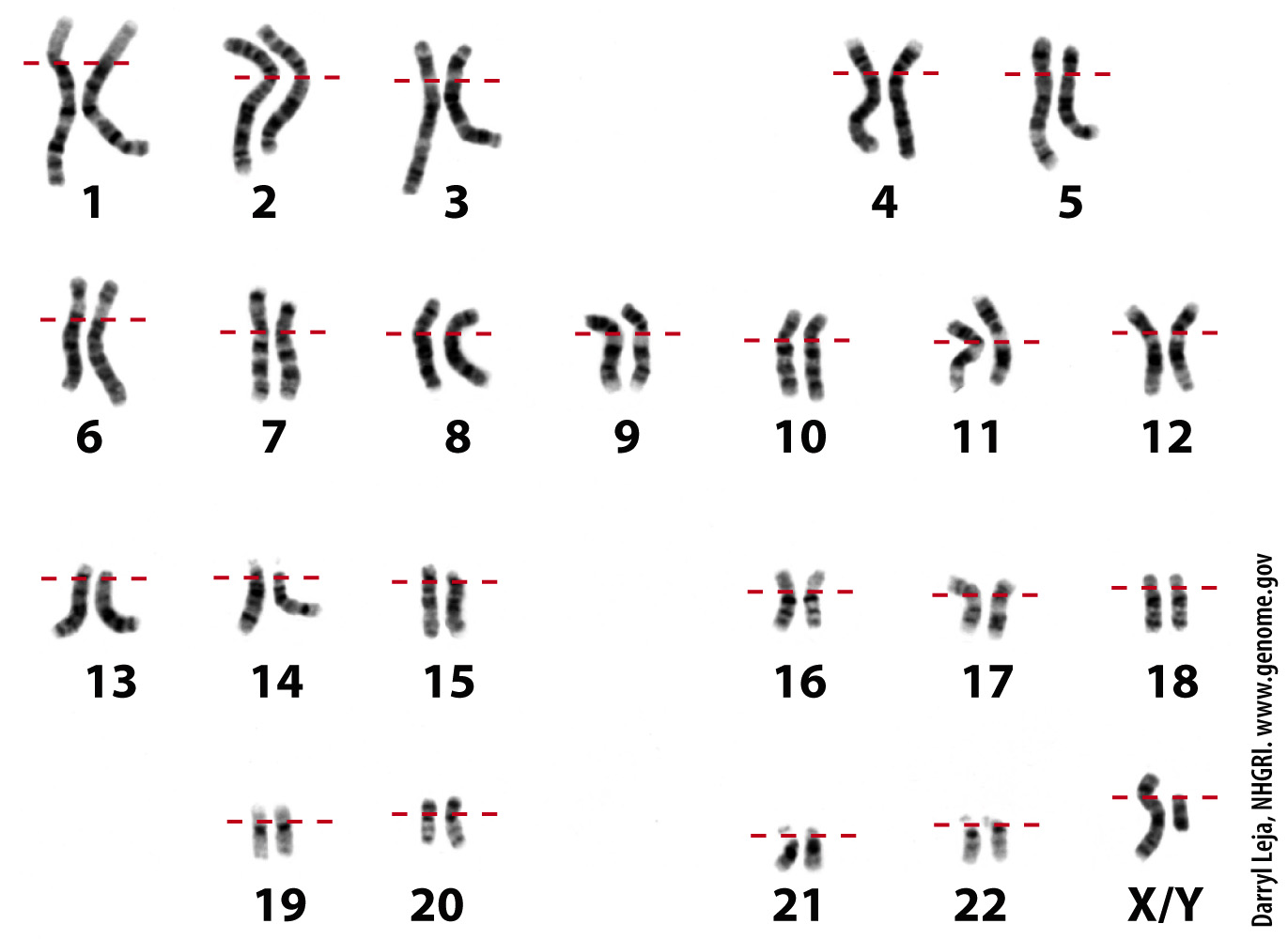The human genome consists of 22 pairs of chromosomes and two sex chromosomes.
As emphasized in Chapter 11, the orderly process of meiosis is possible because chromosomes occur in pairs. The pairs usually match in size, general appearance, and position of the centromere, but there are exceptions, such as the X and Y sex chromosomes. The pairs of chromosomes that match in size and appearance are called homologous chromosomes. The members of each pair of homologous chromosomes have the same genes arranged in the same order along their length. If the DNA duplexes in each pair of homologs were denatured, each DNA strand could form a duplex with its complementary strand from the other homolog. There would be some differences in DNA sequence due to genetic variation, but not so many differences as to prevent DNA hybridization.
283
284
Chromosome painting illustrates the nearly identical nature of the DNA molecules in each pair of homologs. In this technique, individual chromosomes are isolated from cells in metaphase of mitosis. Metaphase of mitosis is the easiest stage in which to isolate chromosomes because of the availability of chemicals that prevent the spindle from forming. These chemicals block the cell cycle at metaphase, so cells progress to metaphase and then stop.
Once the chromosomes have been isolated, the DNA from each chromosome is fragmented, denatured, and labeled with a unique combination of fluorescent dyes. Under fluorescent light, the dyes give the DNA in each type of chromosome a different color. The fluorescently labeled DNA fragments are then mixed with and hybridized to intact metaphase chromosomes from another cell. Each labeled fragment hybridizes to its complementary sequence in the metaphase chromosomes, “painting” each metaphase chromosome with dye-
A chromosome paint of the chromosomes in a human male is shown in Fig. 13.14. Fig. 13.14a shows the chromosomes in the random orientation in which they were found in the metaphase cell, and Fig. 13.14b shows them arranged in a standard form called a karyotype (Chapter 11). To make a karyotype, the images of the homologous chromosomes are arranged in pairs from longest to shortest, with the sex chromosomes placed at the lower right. In this case, the sex chromosomes are XY (one X chromosome and one Y chromosome), indicating that the individual is male; in a female the sex chromosomes would be XX (a pair of X chromosomes). Including the sex chromosomes, humans have 23 pairs of chromosomes.

An important observation from the chromosome paint shown in Fig. 13.14 is that the two members of each pair of homologous chromosomes show the same pattern of fluorescent color. This means that a particular labeled DNA fragment hybridized only with the two homologs of one chromosome. Hence, the DNA in each pair of homologous chromosomes is different from that in any other pair of homologous chromosomes.
Higher resolution of human chromosomes can be obtained by the use of stains that bind preferentially to certain chromosomal regions and produce a visible pattern of bands, or crosswise striations, in the chromosomes. One such stain is the Giemsa stain; a Giemsa-

Every species of eukaryote has its characteristic number of chromosomes. The number differs from one species to the next, with little relation between chromosome number and genome size. Despite variation in number, the rule that chromosomes come in pairs holds up pretty well, with the exception of the sex chromosomes. Polyploids, too, are an exception, but even in naturally occurring polyploids the number of copies of each homologous chromosome is usually an even number, so there are pairs of homologs after all.
285
The occurrence of chromosomes in pairs allows eukaryotes to reproduce sexually. When reproductive cells are formed during meiotic cell division, each cell receives one and only one copy of each of the pairs of homologous chromosomes (Chapter 11). When reproductive cells from two individuals fuse to form an offspring cell, the chromosome number characteristic of the species is reconstituted.